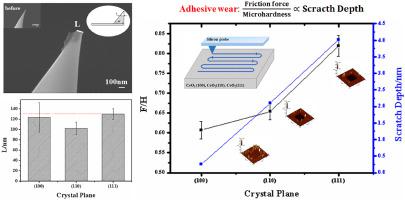当前位置:
X-MOL 学术
›
Tribol. Int.
›
论文详情
Our official English website, www.x-mol.net, welcomes your
feedback! (Note: you will need to create a separate account there.)
Mechanical wear behavior between CeO2(100), CeO2(110), CeO2(111), and silicon studied through atomic force microscopy
Tribology International ( IF 6.1 ) Pub Date : 2021-01-01 , DOI: 10.1016/j.triboint.2020.106616 Lile Xie , Jie Cheng , Tongqing Wang , Xinchun Lu
Tribology International ( IF 6.1 ) Pub Date : 2021-01-01 , DOI: 10.1016/j.triboint.2020.106616 Lile Xie , Jie Cheng , Tongqing Wang , Xinchun Lu

|
Abstract Using atomic force microscopy and scanning electron microscopy, the mechanical removal mechanism of silicon with different exposure surfaces of cerium oxide (CeO2) is studied. It is discovered that the main type of mechanical wear between Si and CeO2 is adhesive wear. The silicon removal rate relationship is RR 1 (CeO2(111))> RR(CeO2(100))> RR(CeO2(110)). Additionally, the relationship of the friction force remains constant: F 2 (CeO2(111)) > F(CeO2(110)) > F(CeO2(100)). This is consistent with the ceria wear rate relationship of WR 3 (CeO2(111)) > WR(CeO2(110)) > WR(CeO2(100)). This paper provides a deeper insight into the mechanical material removal mechanism during chemical mechanical polishing processes; thus, providing a reference for CeO2 particle orientation control.
中文翻译:

通过原子力显微镜研究 CeO2(100)、CeO2(110)、CeO2(111) 和硅之间的机械磨损行为
摘要 利用原子力显微镜和扫描电子显微镜,研究了不同氧化铈(CeO2)暴露面对硅的机械去除机理。发现Si和CeO2之间的主要机械磨损类型是粘着磨损。硅去除速率关系为RR 1 (CeO2(111))> RR(CeO2(100))> RR(CeO2(110))。此外,摩擦力的关系保持不变:F 2 (CeO2(111)) > F(CeO2(110)) > F(CeO2(100))。这与 WR 3 (CeO2(111)) > WR(CeO2(110)) > WR(CeO2(100)) 的氧化铈磨损率关系一致。本文提供了对化学机械抛光过程中机械材料去除机制的更深入了解;从而为CeO2粒子取向控制提供参考。
更新日期:2021-01-01
中文翻译:

通过原子力显微镜研究 CeO2(100)、CeO2(110)、CeO2(111) 和硅之间的机械磨损行为
摘要 利用原子力显微镜和扫描电子显微镜,研究了不同氧化铈(CeO2)暴露面对硅的机械去除机理。发现Si和CeO2之间的主要机械磨损类型是粘着磨损。硅去除速率关系为RR 1 (CeO2(111))> RR(CeO2(100))> RR(CeO2(110))。此外,摩擦力的关系保持不变:F 2 (CeO2(111)) > F(CeO2(110)) > F(CeO2(100))。这与 WR 3 (CeO2(111)) > WR(CeO2(110)) > WR(CeO2(100)) 的氧化铈磨损率关系一致。本文提供了对化学机械抛光过程中机械材料去除机制的更深入了解;从而为CeO2粒子取向控制提供参考。











































 京公网安备 11010802027423号
京公网安备 11010802027423号